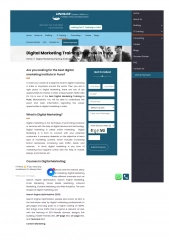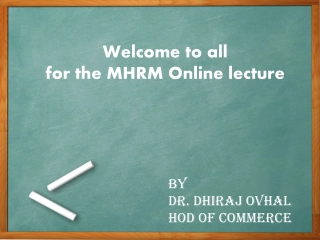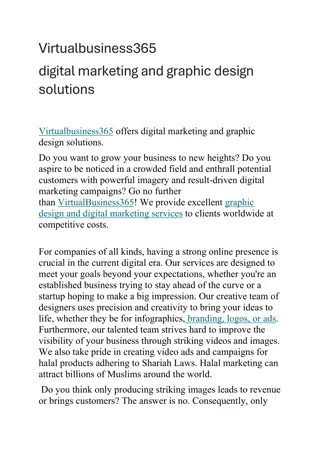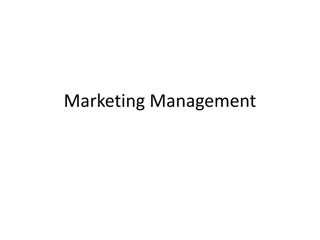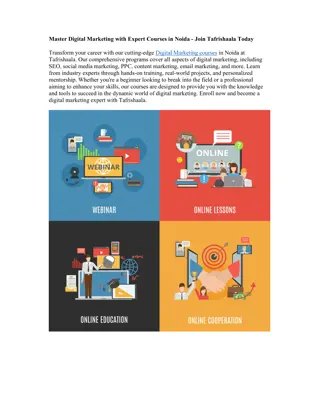Principles of Marketing
Strategic positioning is a key element in marketing to set a product apart from competitors by emphasizing unique value propositions. The process involves understanding market dynamics, identifying competitive advantages, defining a niche, and communicating the strategy effectively.
Download Presentation

Please find below an Image/Link to download the presentation.
The content on the website is provided AS IS for your information and personal use only. It may not be sold, licensed, or shared on other websites without obtaining consent from the author.If you encounter any issues during the download, it is possible that the publisher has removed the file from their server.
You are allowed to download the files provided on this website for personal or commercial use, subject to the condition that they are used lawfully. All files are the property of their respective owners.
The content on the website is provided AS IS for your information and personal use only. It may not be sold, licensed, or shared on other websites without obtaining consent from the author.
E N D
Presentation Transcript
Principles of Marketing Module 8: Positioning
Positioning Positioning is a strategic process that marketers use to determine the place or niche an offering should occupy in a given market, relative to other customer alternatives When you position a product or service, you need to understand Place Rank Attitude Outcomes
Differentiation To make a product or service stand out from its competitors in ways that provide unique value to the customer Identifies a set of characteristics and benefits that make a product different and better for a target audience that: 1. Customers value when they are evaluating choices 2. Competitors cannot easily copy
Positioning vs. Differentiation Name Positioning Differentiators Wal-Mart Wide selection of products people want, at the lowest prices Wide selection; low prices Target Trendy, fashionable products at reasonable prices Continually refreshed, on-trend product selection Macy s Preferred go-to shopping destination for upscale brands and current fashions. Broad selection of most-wanted, upscale brands; engaging shopping experience
Steps of the Positioning Process 1. Confirm your understanding of market dynamics 2. Identify your competitive advantages 3. Choose competitive advantages that define your market niche 4. Define your positioning strategy 5. Communicate and deliver on the positioning strategy
Step 1: Confirm Your Understanding of Market Dynamics A firm understanding of your target market and answers to the following questions: In which product, service, or market category (also called the frame of reference ) do you plan to use this positioning? Which target segment is your focus for the positioning you are developing? What factors do these buyers evaluate when they make a purchasing decision? How do these buyers view your competitors in the category?
Step 2: Identify Your Competitive Advantages A trait, quality, or capability that allows you to outperform the competition Gives your product, service, or brand an advantage over others in purchasing decisions Comes from any or all of the following: Price Features Benefits
Step 3: Choose Competitive Advantages That Define Your Niche
Common Positioning Strategies Differentiator Positioning Strategy Examples Category Benefit Position yourself as owning an important benefit and delivering it better than anyone else Position yourself as an ideal fit for the customer s personality, style, and approach Volvo = Safety Hallmark = Caring shared Hawaii = Aloha spirit Red Bull = Extreme Guess Jeans = Sexy chic Virgin Atlantic = Ultra cool fun Best fit for the Customer Business Approach Position yourself with a distinctive approach to doing business Jimmy John s = Unbelievably fast TurboTax = Easy DIY Apple = Think different Seven-Up = The Uncola Anti-Competition Position yourself as a preferred alternative to the competition Price Position yourself according to pricing: lowest cost, best value for the money, luxury or premium Wal-Mart = Lowest prices Old Navy = Affordable fashion Quality Position yourself according to a quality standard: high quality or else reliably good quality at a reasonable price Hearts on Fire = Perfection Ritz Carlton = luxury
Positioning Statement One sentence that concisely identifies the target market and what you want customers to think about your brand Includes: 1) the target market 2) the brand name 3) the key points of differentiation 4) the product/service category 5) why customers should believe the positioning claims
Formula for Positioning Statement To [target audience], Product X is the only [category or frame of reference] that [points of differentiation/benefits delivered] because [reasons to believe].
Criteria to Evaluate Positioning Statements Is it tailored to the target market? Is it simple, focused, and memorable? Does it provide an unmistakable picture of your product, service, or brand? Can you deliver on the promise you make? Does it provide helpful direction for designing the marketing mix and other decisions?
Reasons to Consider Repositioning Competition New competitors entering or leaving the market; competitors joining forces Competitor s innovation that threatens to make your offering obsolete; competitive pricing strategies Market environment Economic slow-down or recovery Changes in consumer confidence, the political climate, or social forces like the movement around social responsibility and sustainability
More Reasons to Consider Repositioning Consumer trends Changing tastes and preferences Evolving attitudes and behaviors New segments emerging as targets Internal environment Changes in organizational leadership and strategy Acquisition or development of new technology Introduction of innovation that offers new competitive advantages and differentiators
Repositioning and Market Perceptions The repositioning process evaluates the established position of a product, service, or brand and focuses on how to alter the positioning and, with positioning, market perceptions in order to improve competitiveness.
Pitfalls of Repositioning Insufficient research A bridge too far: If brands go too far in a new direction, customers may no longer believe the claims Underestimating back to basics Overpromising Confusing positioning
Implementing a Positioning Strategy How can each part of the marketing mix fulfill the positioning statement?
Product Is your product, service, or brand capable of delivering everything your positioning statement claims? Are any competitors doing it better than you? How should you adjust your offering to ensure that it lives up to the promises?
Price When it comes to pricing, how are you positioning your offering relative to competitors? If pricing is part of your positioning strategy, is your offering well aligned with the price you re asking customers to pay? What pricing strategies should you consider in order to compete more effectively?
Place Are any distribution-related themes like convenience or availability part of your positioning strategy or competitive advantage? If so, what are you doing to ensure that you can live up to what you promise? How are you communicating your new positioning approach to distribution and channel partners, and how does it impact them?
Promotions How are you translating your positioning strategy into communications with your target audiences? What behavioral shift are you trying to create as you launch your new positioning? What types of campaigns will you use to introduce the new positioning? Which communication tools will be most effective at reaching target audiences? What are you doing to coordinate marketing messages and activities across different channels?
Measuring Implementation Sales/revenue Number of new/returning customers Average spending per transaction Brand/product awareness or perceptions Favorability toward product/service/brand New leads or inquiries from inside and outside your target segments Web site traffic or social media buzz Media attention Customer Satisfaction Return on investment for marketing campaigns and other activities
Practice Questions What is the difference between a feature and a benefit?
Quick Review What are positioning and differentiation, and why are they important to marketing a product or service? What is the process of selecting a positioning and differentiation strategy? How do marketers develop and evaluate positioning statements based on defined criteria? How do marketers reposition products or services? What are the associated risks and complexities? What is the process of implementing a positioning strategy?






